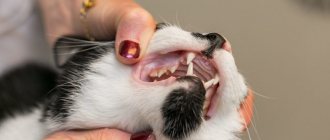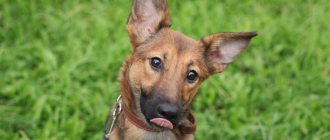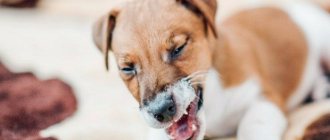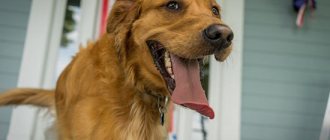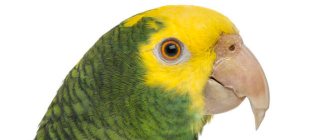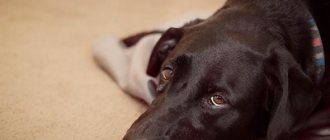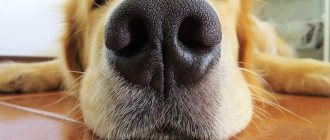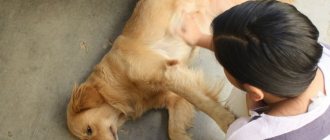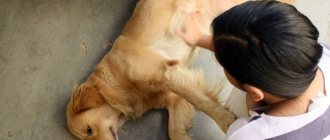Teeth grinding or bruxism in dogs is quite common. It may be a variant of the norm, but more often it indicates pathology. Sometimes a pet grinds its teeth in its sleep, but at some moments the animal suffers seizures while it is awake. Both puppies and adults are susceptible to the disease. In any case, this phenomenon should not be ignored, because during involuntary clenching of the jaws, quite significant harm is caused to the dog’s teeth. They cannot withstand intense friction against each other. In our article you will learn about why a dog clangs and grinds its teeth, and how to deal with it.
Reaction of a male dog to a female dog in heat
Teeth grinding is not always a pathological sign. Male dogs often show sexual arousal. This is especially noticeable if there is a female dog in heat nearby.
Signs of excitement in a male dog:
- small frequent movements of the lower jaw;
- incomplete erection – the penis partially emerges from the prepuce;
- attempts to make cages.
Normally, male dogs begin to experience sexual arousal at 6-8 months. Up to 1-1.5 years, testosterone levels continue to increase, so young males are more active in finding a partner. But constant sexual behavior is formed only by 3-4 years.
Without cages, male dogs may develop atypical behavior - a reaction to other males, people and inanimate objects.
If a male dog reacts by chattering his teeth at a female during a walk, then this is a normal reaction and no action needs to be taken about this (only if you find a partner for mating). But if a male develops a sexual attraction to other males, the owner (other people), or he tries to mount toys and interior items, then it is necessary to work with him:
- at the moment of boarding, remove him and limit him with the commands “Stop”, “Lie down”;
- hide or throw away objects on which the dog is mounting;
- increase the load, add training;
- The radical method is castration.
Although removing the testes is a radical remedy, it does not always help. A number of males retain sexual behavior despite the fact that hormone production has ceased. In this case, it is necessary to continue educational work with the animal - after castration, the dogs become more obedient. It is important not to encourage the male to mount people and other inappropriate objects. Approval will cause a pathological reflex, which will be difficult to remove in the future.
Consequences of bruxism
Teeth grinding cannot continue for long without consequences for the teeth. It all starts with thinning of the enamel and cracks. These injuries become the causes of serious dental pathologies:
- Caries is a pathological process that occurs due to the penetration of pathogenic microorganisms and leads to the destruction of hard dental tissues.
- Pulpitis is an inflammation of the deep tissues of the tooth, which contain a large number of nerve endings and blood vessels. The disease is characterized by paroxysmal pain that increases at night.
- Enamel chips are tooth destruction that exposes soft tissue. For this reason, the dog finds it difficult to chew and experiences pain from cold or hot food.
- Displacement of the dentition occurs if bruxism continues for quite a long time. The front teeth become crooked and move forward. Pressing a molar into the gum leads to gingivitis.
- Ignoring the problem for a long time leads to gradual distortion of the bite.
All dental problems lead to poor chewing and absorption of food, lack of appetite, which affects the general condition and physical fitness of the dog.
When choosing treatment tactics, the veterinarian determines the cause of this deviation. It is especially recommended to diagnose your dog for worm infestation, since this problem is the most common. In addition, it is necessary to regularly examine the animal’s oral cavity for dental problems and take measures to eliminate them as quickly as possible.
Presence of intestinal parasites
Teeth grinding often occurs in dogs with severe intestinal infestation. The pathological effect exerted by worms on the animal’s body causes discomfort and pain, which causes tooth decay. Helminth infections in dogs are accompanied by other clinical signs:
- diarrhea, constipation and other digestive disorders;
- the appearance of blood and mucus in the stool;
- exhaustion, dehydration;
- weakness, depression;
- the appearance of itching in the anal area with a number of invasions.
The diagnosis is established by laboratory tests. Eggs, larvae or adults of parasites are found in stool samples. For this purpose, sedimentation and flotation methods are used. In the first case, a sample of feces is crushed (ground in a mortar with a small amount of water), then the sample is washed into a laboratory beaker with 50-100 ml of water. The preparation is allowed to stand for 30 minutes, after which the supernatant liquid is drained and water is added to the residue. The solution is again left to precipitate and the procedure is repeated until the water above the sediment becomes clear. Now you should place the remaining stool sample on a glass slide and examine it under a microscope. In this way, imaginal and larval forms, as well as large eggs, can be detected.
In most cases, the flotation method is used, since it allows the detection of even small eggs, which are found in many species. To do this, a fecal sample is diluted in a hypertonic solution (saline, glycerin and water, zinc sulfate) and left for 10-30 minutes. After that, a metal loop is used to grab a drop from the surface and transfer it to a glass slide. The study is carried out under a microscope.
Methods of allergy testing and detection of antibodies in blood serum are also used. For treatment, anthelmintic drugs are used, which are prescribed after the detection of parasites and their identification. Complex therapy is also carried out - elimination of secondary pathologies and negative symptoms.
Why do old animals click?
Over the course of its life, the dog receives dental injuries (cracks, chips), wears off tooth enamel, and damages gums. All these factors, combined with poor nutrition, can lead to caries and similar diseases . Caries itself irritates the dental nerve, causing contractions, and the body also tries to get rid of the diseased, infected tooth using this method.
If your dog's teeth are loose or his breath smells bad, he clearly has an oral disease. They can be caused by infections, lifestyle choices, or trauma (such as hot food or bone breaking the gum)
Damage to the neuromuscular system
The dog grinds its teeth due to pathology of the masticatory muscles and pharyngeal muscles caused by the rabies virus. Rabies is a dangerous disease of animals, the causative agent of which affects the nervous system and salivary glands. Infection occurs when a sick animal bites a healthy one. All warm-blooded animals are susceptible to the virus.
Clinical picture:
- appears no earlier than 10-12 days from the moment of the bite;
- From the moment the first symptoms appear until death, up to 3 weeks pass;
- at the initial stage there is lethargy and depression;
- itching appears as the virus penetrates;
- aggressiveness, agitation;
- gnashing of teeth, slack jaw;
- excessive salivation;
- pupils dilated;
- eyes are inactive;
- difficulty swallowing, hydrophobia.
The pathology ends with inflammation of the brain, muscle paralysis and death. The diagnosis is confirmed by biological tests and laboratory tests. Until the results are negative, the dog is isolated and no contact is allowed.
Treatment of dogs for rabies has not been developed, there are no effective methods and means, therefore, if the test is positive, the animal is killed. The development of the disease can be prevented - annual vaccination avoids the development of the virus in the body. You should also avoid contact of your pet with wild and stray animals.
Similar clinical signs can be observed in other dangerous infectious diseases. So, with carnivore distemper, the dog grinds its teeth, and increased salivation is observed in some cases. But in this case, in the acute form, dogs will have serous-purulent conjunctivitis, nasal discharge, and cough. Differential diagnosis and laboratory tests will help identify the cause of the pathological condition.
Body and ambient temperature
If the body temperature drops, the dog's body begins to struggle and responds with severe tremors. Trembling mobilizes the forces of absolutely all systems, raises blood pressure, and increases blood circulation. Excessive tremors may affect the facial muscles.
A similar reaction can be observed if the ambient temperature is low; tremor helps to warm up. This is an absolutely natural reaction, characteristic of both dogs and people. Grinding of teeth can occur after hypothermia for 1–2 days.
Sign of severe pain
Teeth grinding is a common sign of severe pain response. The reasons for pain can be very diverse. In some cases, they are associated with the oral apparatus or organs of the head, but most often these are any systemic changes.
In order to carry out proper treatment, the cause of the pain must be accurately determined. To do this, pay attention to the accompanying symptoms:
- bitches often grind their teeth with endometritis, pyometra. In this case, there will be a discharge of pus or other exudate from the genital organs, and the volume of the abdomen may increase. When the ovaries are involved in the pathological process, bilateral baldness on the sides is detected;
- peritonitis is accompanied by severe pain in the abdominal wall. The abdomen is enlarged in size. The dog has an increased pulse and breathing, severe depression, the temperature is increased to 41 degrees;
- Otitis is manifested by tilting the head towards the affected ear; at the beginning of the disease, the dog will shake its head. Pus may be discharged from the ear. Palpation reveals severe pain, swelling, and increased local temperature.
Identification of the cause is possible only after a complete clinical examination of the animal. The dog's temperature, frequency and pattern of breathing and heart contractions are measured. Changes in behavior, eating, bowel movements and urination are noted. Examine the condition of the outer coverings and lymph nodes.
If necessary, blood is taken for clinical and biochemical analysis. Conduct physiological tests and instrumental studies. A comprehensive examination allows a comprehensive assessment of the animal’s health status.
The choice of treatment should be confirmed only after diagnosis. At first, you can only stop the pathological symptoms, but you should understand that this can blur the clinical picture. Treating teeth chattering in dogs can only be done by eliminating normal behavior.
Diagnosis of diseases of the temporomandibular joint
Only a doctor can make a diagnosis. In order to determine not only the disease itself, but also its cause, it is advisable to contact us at the first complaints. The symptoms that accompany jaw clicking can be specific, which can help with diagnosis. In addition to the survey, the doctor does an examination, during which the features of the bite and teeth are revealed: the presence of caries, fillings, prosthetics. An additional diagnostic method is x-ray examination. The photographs show the consequences of injury, inflammation and signs of arthrosis.
Chin tremor in a newborn: the child's chin trembles
In most cases, these symptoms disappear completely with timely diagnosis and treatment, especially if treatment is started in the first six months of the child’s life.
When a newborn baby's chin trembles, this almost always indicates increased stimulation of the nervous system. If the chin trembles frequently or constantly, it means that excitation in the child’s central nervous system significantly dominates inhibition. And this, in turn, may indicate a history of brain damage: intrauterine infection, intrauterine and/or birth hypoxia, birth trauma, increased intracranial pressure, etc. In this case, the child’s chin shakes while crying or spontaneously. Other neurological symptoms may also appear. An increase in muscle tone is often observed; the baby does not form the correct reflexes inherent in newborns: proboscis reflex, palmar-mental, palmo-oral, support reflexes. There may also be other neurological signs indicating that the nervous system has been damaged in some way. In more serious cases, early development may be impaired.
Where to start and who to contact? If a child often experiences chin trembling, first of all, he should get an in-person consultation with a pediatric neurologist. The doctor will examine the baby and, if necessary, prescribe an ultrasound of the brain and ultrasound of the cerebral vessels to look at the situation with intracranial pressure and cerebral circulation. If epilepsy is suspected, encephalography (EEG) is advisable. As a rule, the most relevant age for research and determination of the causes of this problem is up to six months, since most of the consequences of intrauterine and birth damage to the nervous system are well restored during the first 6-12 months of life (the so-called “therapeutic window”). It is at this moment that every effort should be made to ensure that the damaged functions are fully restored and continue their development as normal.
Worm infestation
Helminths are not a rare occurrence among dogs; many animals carry them. If there are few worms living in the intestines, then they do not cause unpleasant symptoms to the body. However, oversaturation will lead to pain and bloating in the abdomen.
This type of worm takes away many nutrients and spreads toxins, which weakens the animal’s immunity and increases the likelihood of pathologies.
Helminths that live in other organs damage biological tissues and sometimes even affect the brain. This causes neurological symptoms: teeth grinding, blurred vision and disorientation.
Toxocariasis is more common in puppies. Additional signs indicate the disease:
- disruptions in the gastrointestinal tract (diarrhea, constipation);
- weak weight gain with normal appetite;
- relatively slow development;
- itching in the anal area.
Why does a dog chatter its teeth and what does it mean?
The dog is chattering its teeth, what does this mean? – This question is of interest to many breeders today who are faced with this problem. However, this may be an ordinary chill or other harmless manifestation, but it may also indicate that some pathological process is developing in the pet’s body, which urgently needs to be diagnosed and, if possible, eliminated.
Thus, it is imperative to consult a veterinarian to ensure that the disease does not become chronic and significantly affect the health of the pet.
Oral diseases
Grinding is often a result of physical pain caused by problems with teeth or gums:
- Malocclusion. The defect is indicated by damage to the oral mucosa, abrasion and chipping of teeth, and bleeding gums. This disease is often inherited, but it is acceptable for the Shih Tzu and English Bulldog breeds. If your pet has a normal scissor-shaped arrangement of teeth, then there should be no extraneous sounds.
- Incorrect growth of incisors. It occurs in dogs whose jaw muscles were often overloaded in childhood. To avoid the problem, do not play games with tugging objects until the baby incisors and molars are replaced by bone teeth.
- Non-standard number of teeth. The hereditary condition will negatively affect the general condition of the oral cavity and cause unpleasant sounds.
- Incorrect jaw position. A defect that often leads to disability. Diagnosis is possible during the dog’s childhood. Passed on by inheritance.
- Stones and plaque. Foreign accumulations in the mouth cause discomfort to animals and lead to decreased appetite. Teeth grinding, characteristic of this situation, most often occurs during sleep.
- Gingivitis. Inflamed gums are especially painful when eating. This leads to a decrease in appetite and then gives rise to dysfunction of the digestive system.
What to do if your dog grinds his teeth
If you notice that your dog is grinding his teeth, you should make an appointment with your veterinarian to determine what is causing him to do this. Your veterinarian will perform a complete physical examination of your dog. If he notices that your dog's jaw is misaligned, which could be causing teeth grinding, he may recommend that you see a veterinary orthodontist who can help correct the problem.
If your veterinarian determines that your dog is grinding his teeth because of the pain he is experiencing, he will try to determine the location of the pain and its cause, and then treat the pain accordingly. For example, pain may be present in your dog's mouth, perhaps with one or more of your dog's teeth requiring extraction or other treatment.
If there are no problems with the alignment of your dog's teeth and he is not in pain, his teeth grinding may be the result of anxiety or stress. In this case, your veterinarian may recommend medication to help your dog cope with anxiety, as well as behavioral therapy for teeth grinding.
© shutterstock
Problems with the gastrointestinal tract
Teeth grinding occurs with stomach pain and nausea. For example, when a dog gets seasick or gets poisoned.
Symptoms of the condition are as follows:
- licking the nose and chin with the tongue;
- lack of appetite, but drinking plenty of water;
- excessive saliva production;
- increased anxiety;
- chaotic movement of the jaw (source of creaking).
Gastrointestinal disorder is also caused by allergies to food, medicines and household products. In rare cases, this factor is also accompanied by grinding in the mouth.
